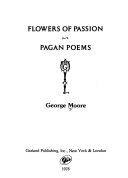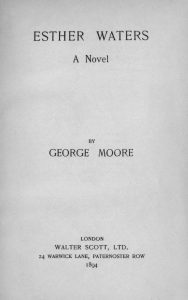George Augustus Moore was born on 24th February 1852 in Ballyglass, County Mayo, Ireland. The Irish novelist, short-story writer, poet, art critic, memoirist and dramatist was an influence in the late 19th century.
George Moore: Short Biography
He is remembered as the propagator of Naturalism in English and Irish literature. He was also a Modernist in his rebellion against Victorian mores and conventions.
George Moore was a novelist, poet, and dramatist of Irish origin. He is attributed with influencing not only the Irish but also the English literature of the Victorian era.
“A great artist is always before his time or behind it.” – George Moore.
He was an audacious writer whose works generally hovered over the most controversial and taboo topics of the Victorian period such as homosexuality, sex, prostitution, and adultery. Most of his works are filled with realism and are, therefore, quite relatable.
Early Life
George Moore’s came from a Catholic family of Irish landholders. His family had lived in Moore Hall, near Lough Carra, County Mao for a century. As a child, Moore cherished the works of Walter Scott, which his father read to him. He spent most of his time with his brother, Maurice George Moore, and befriended the young Willie and Oscar Wilde during the summer holidays.

Moore’s education started at St. Mary’s College, Oscott, a Catholic boarding school near Birmingham. He was a rebel who refused to study and spent time reading novels and poems. Eventually, Moore was expelled in the summer of 1867.
Art Student
In 1868, George Moore moved with his family to London. He unsuccessfully attended the School of Art in the South Kensington Museum. Moore handed over his family estate to his brother Maurice when their father died in 1870.
He was in search of an artist who would accept him as a pupil. A shepherd and circus masked man, Monsieur Jullian, took him as a pupil for 40 francs a month.
Paris
At the age of 21, George Moore left for Paris. He self-published his first book, a collection of lyric poems called The Flowers of Passion in 1877. Moore also described the Café Nouvelle-Athenes and the impressionist painters who visited it in Reminiscences of the Impressionist Painters.
Moore befriended Édouard Manet, who sketched three portraits of him. He was forced to return to Ireland in 1880 to raise £3,000 to pay debts sustained on the family estate due to his tenants refusing to pay the rent and the drop in agricultural prices.
London
While in Ireland, George Moore decided to abandon art and move to London to become a professional writer. His first novels, A Modern Lover and A Mummer’s Wife, introduced a new note of French Naturalism into the English scene. He published his second poetry collection Pagan Poems.
He introduced the younger generation in England to his version of fin de siècle, his first autobiography, Confessions of a Young Man. The Modern Library chose it in 1917 to be included in the series as “one of the most significant documents of the passionate revolt of English literature against the Victorian tradition.”
Moore had an interest in tackling issues such as prostitution, extramarital sex, and lesbianism. Because of this, he had to face controversy in his career.
Legacy
Esther Waters (1894), deals with the plight of a servant girl who has a baby out of wedlock; it is a story of hardship and humiliation illumined by the novelist’s compassion, and is still his best work.
Moore died at his home at Ebury Street in the London district of Belgravia in 1933, leaving a fortune of £70,000. Moore’s contribution to the Irish Literary Renaissance and to the development of the Irish National Theatre is unmatched.
He published his first poem in 1877 titled, ‘The Flowers of Passion’ but was compelled to return to his homeland, England because of a few financial problems in 1879. He, however, did not cease to create literature.
Most notable works, categorized by type:
Novels:
- “A Modern Lover” (1883)
- “A Mummer’s Wife” (1885)
- “A Drama in Muslin” (1886)
- “A Mere Accident” (1887)
- “Spring Days” (1888)
- “Mike Fletcher” (1889)
- “Vain Fortune” (1891)
- “Esther Waters” (1894)
- “Evelyn Innes” (1898)
- “Sister Teresa” (1901)
- “The Lake” (1905)
- “Muslin” (1915)
- “The Brook Kerith” (1916)
- “Lewis Seymour and Some Women” (1917)
- “A Story-Teller’s Holiday” (1918)
- “Heloise and Abelard” (1921)
- “Ulick and Soracha” (1926)
- “Conversations in Ebury Street” (1924)
- “Aphrodite in Aulis” (1930)
Short Stories:
- “Celibates” (1895)
- “The Untilled Field” (1903)
- “The Exile” (1914)
Plays:
- “The Strike at Arlingford” (1893)
- “The Bending of the Bough” (1900)
- “Elizabeth Cooper” (1913)
Poetry:
- “Flowers of Passion” (1877)
- “Pagan Poems” (1881)
Memoirs:
- “Confessions of a Young Man” (1888)
- “Hail and Farewell” (1911-1914) – This is a trilogy consisting of “Ave,” “Salve,” and “Vale.”
Essays and Criticism:
- “Modern Painting” (1893)
- “Impressions and Opinions” (1891)
This list covers many of George Moore’s most influential and well-known works, but he wrote other lesser-known pieces as well.

After getting inspired by Emile Zola’s contribution of naturalism to French literature, George published his first novel, ‘A Modern Lover,’ in 1883.
In this, he introduced naturalism as an element. Later, he went on to publish ‘A Mummer’s Wife,’ ‘A Drama in Muslin,’ and ‘A Mere Accident,’ in the years 1885, 1886 and 1887 respectively.
George Moore Facts
Although he was criticized for his realistic and bold writing approach on provocative subjects from his very first novel, readers gradually took a liking to his realism. This marked the success of his literary career.
However, it was only in 1894 that he found financial stability when he published his most eminent novel ‘Esther Waters.’ The release of this book solidified his fame.

He then moved to Ireland in the year 1901 and worked with the memorable poet, W. B. Yeats. They established a theatre called the Irish National Theatre and co-wrote plays. ‘The Confessions of a Young Man,’ his autobiography still remains one of his most outstanding works.
Personal Life of George Moore
George Moore was in a relationship with a woman named Lady Maud Cunard but was never married. Moore is said to be the father of her daughter, Nancy, but there is no such proof of this story.
Moore experienced problems with his kidney during his final years and died at 80 in the year 1933. Although he was quite wealthy by the time he died, he did not leave any money for his family.
Keeping his personal life aside, it wouldn’t be wrong to say that he has given his best to the field of literature. It seems that he meant his aforementioned quote solely for himself.